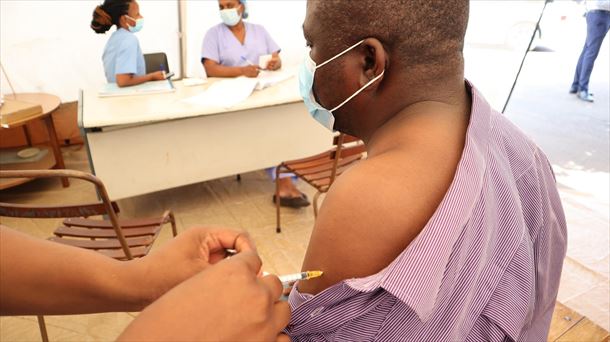Russia already records 1,734 surrenders at the steel plant, including that of a high command of the Azov regiment
How many fighters are left in the cellars of the Azovstal steel factory? It is the question the Russian military commanders are asking and the Ukrainian authorities are refusing to reveal. It is also this uncertainty that prompted the Kremlin this Thursday to unleash another heavy bombardment on the steel mill to avoid the risk of an ambush and force the exit of all resistance fighters. The projectiles fell for the umpteenth time and Mariupol mayor Vadym Boychenko warned that the repeat of the air strikes has brought the region to the brink of a “massive environmental disaster” due to the possible rupture of the chemical depots, which will be seen in the coming days as they seep into the underground streams.
The Russian army is convinced that the absolute fall of Azovstal will take place within hours, as the Ukrainians have been without ammunition for four days and the surrender this Thursday of the deputy commander of the Azov regiment, Svyatoslav Palamar, opens the door for other commanders retrace their steps and solve another question from Moscow: Which battalion commanders are most hated by Russia and stuck in the factory?
The accounts don’t match Vladimir Putin’s government. After the evacuation a week ago of the last children, women and elderly refugees in these facilities, Kiev dropped the figure that about a thousand fighters were maintaining the resistance. In 72 hours, however, 1,730 have already surrendered, including soldiers, police and members of the National Guard. Of them, 771 surrendered this Thursday and were transferred to hospitals and detention centers under Russian control. A total of 88 injuries were reported.
The Red Cross denounced the obstacles to his work, but managed to identify “hundreds” of those arrested before they were transferred to the detention camps of Olenivka, Novoazovsk (of which 53 wounded remain in hospital) and Taganrog, on the shores of the Sea of Azov. The United Nations is paying utmost attention to ensure that “forced disappearances” do not take place among a depressed mob paraded in front of Russian cameras before boarding the buses. Several detainees walked with crutches. Most were exhausted.
The Red Cross has asked both sides to grant access to the massive steel mill to pick up “the dead”, who are guessed by “hundreds”. Kiev assumes the rescuers will face a massacre, including civilians, given the length and brutality of the siege. Will there be children? “Nobody knows exact data, neither about the living nor about the dead. The head of the children’s service is not alive,” said prosecutor Yulia Osenko.
The delivery of Svyatoslav Palamar stimulated the Russian commanders, who consider the capture of the leaders of the Azov regiment as one of the great victories of the siege. Deputy Commander “Kalina,” as he is known, had criticized the Zelensky Executive, explaining that “our leaders should have responded sooner” so that the invaders did not close supply routes to the factory. Palamar pointed out that the government’s insistence on maintaining the defenses is “impossible” and demanded that it “do everything possible to save its soldiers”.
The future of the detainees is now uncertain. Kiev, the Red Cross and the UN are negotiating a prisoner exchange with Moscow, although in this part more and more voices are calling for limiting it to the police and punishing Azov regiment members for terrorism. Such a verdict can lead to execution.
The Kremlin hopes to find some of the most wanted commanders among the refugees. Among them is Denys Prokopenko, who could be joined by some militia members of the “White Boys”, former hooligans with a reputation for being one of the most ruthless sections of the battalion. Listed for dead days ago, Prokopenko later posted a video reporting that he was fighting in Mariupol. If so, he shares a trench with Lieutenant Illia Samoilenko, 27, deputy coordinator of the Azovstal resistance. He recently acknowledged that the invaders are “attacking in waves and exhausting us. We can’t recover between rounds.” Samoilenko expressed the harshness of the situation and expressed his hopes for an agreed surrender: “Surrender is unacceptable. To be captured means to be dead.”
Who the invading army will not find is Andriy Biletsky, founder of the regiment. This Thursday he appeared from an anonymous place to report that he is keeping in touch with his colleagues and asking that there be no speculation about the evacuation. “The most important thing now is not to damage the operation to save the soldiers. Anyone who wants to share their opinion about what is happening in Azovstal, or those who have inside information, keep it to yourself,” he stressed.
Russian troops on Thursday continued their advance towards the city of Severodonetsk, in the east of the country, where 12 people were killed and 40 injured in bombing. Intelligence agencies believe that the Kremlin is building fortifications in the conquered areas of the Donetsk and Luhansk regions with a view to annexation to the Russian Federation. Zelensky promises to get them back, but discouragement seems to be spreading among some of the population. “The propaganda tells us to be proud every day and every hour. But where is the water? where are the mobilized? Where’s the work?” criticizes Sergei, a Donetsk resident who denounces his fatigue with the growing corruption of money changers or bus owners “asking 400 euros to take us to Kiev”.
Source: La Verdad
I am an experienced and passionate journalist with a strong track record in news website reporting. I specialize in technology coverage, breaking stories on the latest developments and trends from around the world. Working for Today Times Live has given me the opportunity to write thought-provoking pieces that have caught the attention of many readers.



